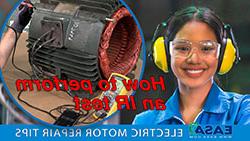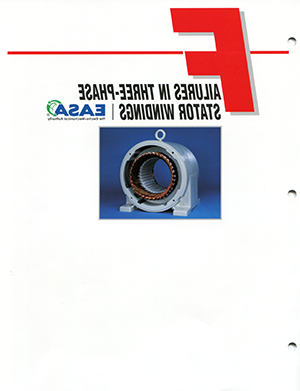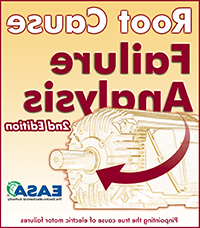Failures in Three-Phase Stator Windings
All photographs are copyrighted © 1985-2019 by EASA. All rights are reserved.
Reproduction of these photographs by print or electronic means is prohibited.
The life of a three-phase stator winding can be shortened dramatically when the motor is exposed to unfavorable operating conditions — electrical, mechanical or environmental. The winding failures illustrated here are typical of what can happen is such circumstances. Failures are shown here to help identify the causes of failure, so that, where possible, preventative measures may be taken.
Winding single-phased (wye-connected)

A single-phased winding failure is the result of an open in one phase of the power supply to the motor. The open is usually caused by a blown fuse, an open contactor, a broken power line or bad connections.
Winding single-phased (delta-connected)

A single-phased winding failure is the result of an open in one phase of the power supply to the motor. The open is usually caused by a blown fuse, an open contactor, a broken power line or bad connections.
Winding shorted phase-to-phase

This type of insulation failure is typically caused by contaminants, abrasion, vibration or voltage surge.
Winding shorted turn-to-turn

This type of insulation failure is typically caused by contaminants, abrasion, vibration or voltage surge.
Winding with shorted coil

This type of insulation failure is typically caused by contaminants, abrasion, vibration or voltage surge.
Winding grounded at edge of slot

This type of insulation failure is typically caused by contaminants, abrasion, vibration or voltage surge.
Phase damage due to unbalanced voltage

Thermal deterioration of insulation in one phase of the stator winding can result from unequal voltage between phases. Unequal voltages usually are caused by unbalanced loads on the power source, a poor connection at the motor terminal, or a high resistance contact (weak spring). Note: A one-percent voltage unbalance may result in a six- to ten-percent current unbalance.
Winding damaged due to overload

Thermal deterioration of the insulation in all phases of the stator winding typically is caused by load demands exceeding the rating of the motor. Note: Under-voltage and over-voltage (exceeding NEMA standards) will result in the same type of insulation deterioration.

 Having trouble finding time for training? Check out the how-to videos in EASA’s new series Electric Motor Repair Tips.
Having trouble finding time for training? Check out the how-to videos in EASA’s new series Electric Motor Repair Tips.



 A tri-fold brochure containing the information on this page is available for purchase. This makes the perfect handout for your employees! Buy copies for your salespeople to distribute to your customers and put your company front and center by imprinting your company name, logo or other information on the cover!
A tri-fold brochure containing the information on this page is available for purchase. This makes the perfect handout for your employees! Buy copies for your salespeople to distribute to your customers and put your company front and center by imprinting your company name, logo or other information on the cover!
 Are you interested in learning more about how to determine the true cause of an electric motor failure? EASA's Root Cause Failure Analysis manual covers root cause methodology and the specfic stresses that affect each component of an electric motor.
Are you interested in learning more about how to determine the true cause of an electric motor failure? EASA's Root Cause Failure Analysis manual covers root cause methodology and the specfic stresses that affect each component of an electric motor.



